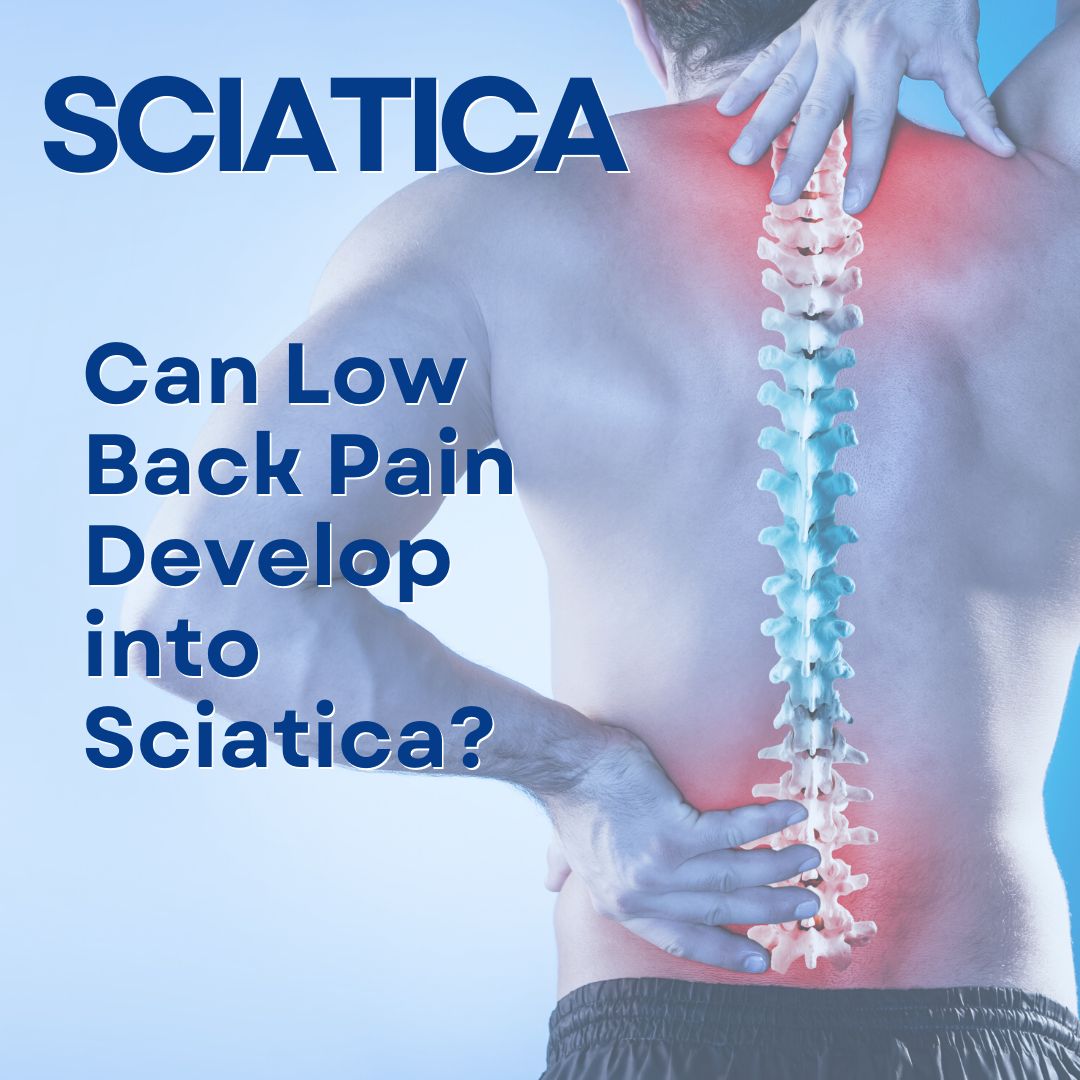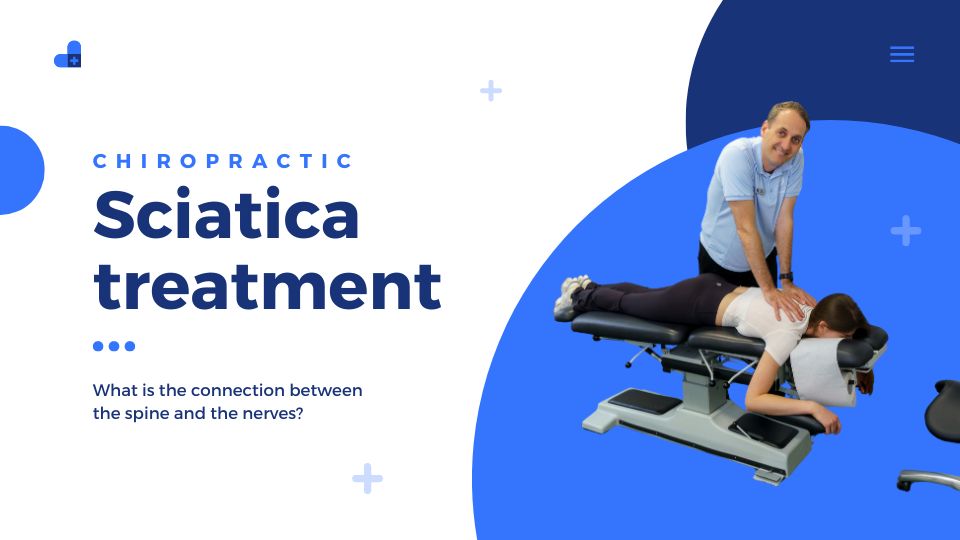
Can Low Back Pain Develop into Sciatica?
Lots of our patients and indeed millions of people worldwide grapple with low back pain, a condition that ranges from mild discomfort to chronic, debilitating agony. While it’s tempting to dismiss back pain as a temporary nuisance, ignoring it can lead to more serious issues, including sciatica. In this comprehensive guide, we’ll explore the intricate relationship between low back pain and sciatica, examine how one can evolve into the other, and discuss how chiropractic care offers effective relief and treatment for both conditions.
Decoding Low Back Pain
Low back pain is a pervasive issue stemming from various causes, including:
- Sedentary lifestyle
- Degenerative disc disease
- Poor posture
- Herniated discs
- Obesity
- Muscle strain or ligament sprain
- Spinal stenosis
- Arthritis
While some instances of low back pain may resolve independently with rest and self-care, persistent or recurring pain shouldn’t be ignored. Untreated low back pain can pave the way for chronic issues and potentially morph into more severe conditions like sciatica.
Unraveling Sciatica
Sciatica describes the symptoms that occur when the sciatic nerve – the body’s longest nerve – becomes compressed or irritated. This nerve extends from the lower back, through the buttocks, and down each leg. When irritated, it can trigger a range of symptoms, such as:
- Numbness or tingling sensation in the leg or foot
- Difficulty moving or standing for extended periods
- Sharp, shooting pain radiating from the lower back down the leg
- Burning sensation along the nerve path
- Weakness in the affected leg

The Bridge Between Low Back Pain and Sciatica
While not all cases of low back pain progress to sciatica, there’s a significant connection between the two conditions. Untreated low back pain can create circumstances that increase the likelihood of developing sciatica. Here’s how this progression can unfold:
- Spinal Misalignment
Persistent low back pain can be both a symptom and a cause of spinal misalignment. Improperly aligned vertebrae in the lower back can exert pressure on surrounding nerves, including the sciatic nerve. Over time, this misalignment may worsen, heightening the risk of sciatica development.
- Inflammation and Swelling
Chronic low back pain often involves ongoing inflammation in the affected area. This inflammation can spread to surrounding tissues, potentially irritating the sciatic nerve and contributing to sciatica development.
- Muscle Imbalances and Weakness
Long-standing low back pain frequently leads to changes in movement patterns and posture. As individuals try to avoid pain, they may unknowingly place additional stress on other body parts. This compensation can result in muscle imbalances and weakness, particularly in the core and gluteal muscles, potentially altering spine and pelvis alignment and increasing pressure on the sciatic nerve.
- Postural Changes
Those suffering from chronic low back pain often adjust their posture to alleviate discomfort. While providing temporary relief, these changes can place additional stress on the spine and surrounding structures. Over time, these postural adaptations may contribute to sciatic nerve compression or irritation.
- Disc Degeneration and Herniation
Chronic low back pain may signal underlying disc issues. As discs degenerate or herniate due to prolonged stress or injury, they can bulge or rupture, putting pressure on the sciatic nerve. Ignoring low back pain may allow these disc problems to progress, eventually triggering sciatica.
Unveiling the Common Causes of Sciatica
Understanding sciatica’s underlying causes is crucial for both prevention and treatment. Some of the most frequent reasons for sciatica include:
- Piriformis Syndrome: The piriformis muscle in the buttocks can sometimes irritate the sciatic nerve passing beneath or through it.
- Spinal Stenosis: This condition involves narrowing of the spinal canal, potentially pressuring nerves passing through it.
- Spondylolisthesis: This occurs when one vertebra slips forward over the one below it, potentially compressing the sciatic nerve.
- Trauma or Injury: Direct injury to the lower back or pelvis can lead to inflammation and sciatic nerve compression.
- Herniated or Bulging Discs: When a spinal disc’s soft inner material protrudes through its tougher outer layer, it can press on nearby nerves, including the sciatic nerve.
- Degenerative Disc Disease: As we age, spinal discs can wear down, potentially leading to nerve compression and sciatica.
- Pregnancy: Weight distribution changes and hormonal shifts during pregnancy can sometimes lead to sciatic nerve compression.

Chiropractic Care: A Comprehensive Approach to Low Back Pain and Sciatica
Chiropractic treatment offers a non-invasive, drug-free approach to managing both low back pain and sciatica. Chiropractors specialise in diagnosing and treating musculoskeletal disorders, with a particular focus on the spine. Here’s how chiropractic care can help with these conditions:
- Soft Tissue Therapy
Chiropractors often incorporate soft tissue therapies to address muscle tension and imbalances. These may include:
– Trigger point therapy
– Myofascial release
– Stretching exercises
These techniques can help relax tight muscles, improve circulation, and reduce inflammation, all contributing to pain relief and improved function.
- Spinal Manipulation
The cornerstone of chiropractic treatment is spinal manipulation, also known as chiropractic adjustment. This technique involves applying controlled force to specific spine joints to improve alignment, reduce pain, and enhance overall function. For low back pain and sciatica, these adjustments can:
– Enhance overall mobility and flexibility
– Relieve pressure on compressed nerves
– Reduce inflammation in the affected area
– Improve spinal alignment
Chiropractic manipulation is particularly effective in addressing the root causes of both low back pain and sciatica, rather than just masking symptoms.
- Lifestyle Counseling
Chiropractors take a holistic approach to health, often providing advice on diet, stress management, and overall wellness. These lifestyle factors can significantly influence low back pain management and sciatica prevention.
- Exercise Prescription
A crucial part of chiropractic care involves prescribing specific exercises tailored to each patient’s needs. These exercises aim to:
– Promote proper movement patterns
– Enhance spinal stability
– Strengthen core muscles
– Improve flexibility
By incorporating these exercises into their daily routine, patients can actively participate in their recovery and prevent future issues.
- Posture and Ergonomic Advice
Chiropractors provide valuable guidance on proper posture and ergonomics. By teaching patients how to maintain correct alignment during daily activities, they can help prevent future low back pain episodes and reduce sciatica risk.
- Non-Invasive Pain Relief
Chiropractic care offers a non-invasive alternative to more aggressive treatments like surgery or long-term medication use. This approach focuses on addressing pain’s underlying causes rather than simply masking symptoms.
The Advantages of Chiropractic Care for Low Back Pain and Sciatica
Opting for chiropractic treatment for low back pain and sciatica offers several benefits:
- Preventive Care: Regular chiropractic visits can help maintain spinal health and prevent future episodes of low back pain or sciatica.
- Personalized Treatment: Chiropractors develop individualized treatment plans based on each patient’s specific needs and condition.
- Natural Approach: Chiropractic care focuses on the body’s innate ability to heal itself, promoting natural recovery without drugs or surgery.
- Addressing Root Causes: Rather than just treating symptoms, chiropractic care aims to identify and correct the underlying issues causing pain.
- Complementary Care: Chiropractic treatment can be safely combined with other forms of therapy for a comprehensive approach to pain management.
- Improved Overall Function: By enhancing spinal alignment and nervous system function, chiropractic care can improve overall health and well-being.
Conclusion: Prioritising Your Spinal Health
Low back pain should never be ignored as a minor inconvenience. As we’ve explored, untreated back pain can potentially evolve into more serious conditions like sciatica, leading to increased discomfort and decreased quality of life. The good news is that chiropractic care offers an effective, natural solution for both low back pain and sciatica.
If you’re experiencing persistent low back pain or sciatica symptoms such as shooting leg pain or numbness, it’s crucial to seek professional help. A qualified chiropractor can provide a thorough assessment of your condition and develop a personalized treatment plan to address your unique needs.
Remember, early intervention is key in preventing low back pain’s progression to sciatica. By taking proactive steps to maintain your spinal health through chiropractic care, you can enjoy a life with less pain, improved mobility, and better overall well-being.
Don’t let low back pain control your life or potentially develop into sciatica. Reach out to a chiropractor today and take the first step towards lasting relief and improved spinal health. Your body will thank you for it!
BY: Oliver Crawford
Uncategorized
COMMENTS: No Comments
